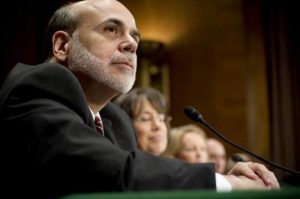
Ben Bernanke, 14th Chairman of the Federal Reserve
Thursday, August 9, 2012
The really great thing about writing your own blog is the boldness of it, the way you can say things – talk about big, important ideas that other people, professional politicians in this case, and their advisors, have spent all matter of time thinking about – as if you really know what you’re talking about. I love it, and I do. …Actually, I’m nowhere nearly as confident as what I write sometimes sounds. My primary objective is to get our elected representatives and their challengers thinking, to open up their minds and focus on solving problems rather than just bickering about them. If I make some headway toward that end, then I did good and “The Next Contestant” wasn’t a waste of time.
This is the second in my series on how the President and Congress can create more effective legislation to help the economy recover. The first article, “Part 1: The Magnificent Seven,” established seven principles in the context of which economic recovery legislation should be crafted. This article is about the usefulness and uselessness of monetary policy.
Monetary policy is about changing the price of money. Money, aka “capital,” is like any other resource that goes in to the production of a good or service. Raise the price of it, and you discourage its use. Lower the price of it, and borrowers, assuming financial institutions pass those lower prices along, are tempted to use more of it – and that, if they succumb to that temptation, can stimulate the economy and result in jobs creation. At least that’s the idea.
The price of money is the interest rates companies and families pay for debt. If I’m a company, so the theory goes, thinking about building a mall or factory, and if I need to borrow money to make that investment, lower interest rates will encourage me. The same principal applies to a family considering purchasing a new car, remodeling a kitchen or buying a house. The lower the interest rate, the smaller the monthly payments, the more affordable the investment.
So why doesn’t the government just do whatever it has to lower interest rates? In fact, it has. Monetary policy is primarily the domain of the Federal Reserve. On it’s website, the FED describes it’s purpose as “conducting the nation’s monetary policy by influencing money and credit conditions in the economy in pursuit of full employment and stable prices.” Without question, under the leadership of FED Chairman Ben Bernanke, the Federal Reserve has done every possible to lower the cost of money by reducing the costs of funds to member banks and by purchasing securities (increasing the supply of money in circulation) in ways which will lower short-term and long-term rates of interest.
What does increasing the volume of money have to do with anything? Remember, money is just a resource, like any other good or service that is used by the economy. Increase the supply of anything, relative existing demand, and market forces drive the price of the resource (interest rates) down.
How, precisely, all this monetary policy happens is complicated, but the details don’t change the basic fact. Money is a resource, an ingredient that banks, corporations and families who use money will consume and disseminate at their own discretion. And that’s the problem, the last four words that I italicized. The FED has, for example, held the interest rates it charges its members to near 0% for more than three and half years – and still banks are hesitant to lend. And even when those banks have lowered their rates to their corporate and family customers, those companies and those people have been hesitant to borrow. Why is that?
What’s going on is the human nature of business. Changing the cost of a resource, money in this case, is a “supply-side” concept. Just because you lower the cost of making an investment or purchase, doesn’t mean that investment or purchase is suddenly a good idea when it wasn’t ten minutes ago before interest rates went down. It only means that it’s a little bit less expensive investment or purchase – less expensive alright, but not by enough to make up for the uncertainty and risk that people perceive. Even when the cost of money is 0%, you’ve still got to pay back the money you borrow. (Conversely, if profits were a sure thing, if people have no job insecurity and believe, with certainty, they’ll be making more in the future, they won’t let higher interest rates stop them.)
Monetary policy can help tweak the economy by controlling rates of inflation – the classic problem of too much money chasing too few goods. But it’s a supply-side economic tool that can’t take the lead in encouraging an economic recovery, certainly not from a deep recession with the structural economic issues we’re facing.
All this is both good news and bad news for the President and Congress. The good news is that they can’t make monetary policy anyway, so why worry about it? The bad news is that they can’t defer to or depend upon the FED to save the economy. Chairman Bernanke has told them as much in his testimony before Congress. “Congress is in charge here, not the Federal Reserve,” he said on July 17, just three weeks ago.
No, Mr. President, Members of the House and Senate. If government is going to help the economy recover, it’s going to be because you conceive and implement effective fiscal policies, the likes of which you have yet to devise, the proof being in the pudding, in the lack of progress you’ve all made toward reducing un- and under-employment.
-Next Contestant
The entire series:
Part 1: The Magnificent Seven
Part 2: The Impotence of Monetary Policy
Part 3: Why don’t President Obama’s fiscal policies work?
Part 4: What’s wrong with tax-related fiscal policies?
Part 5: What can we do to encourage a recovery?

